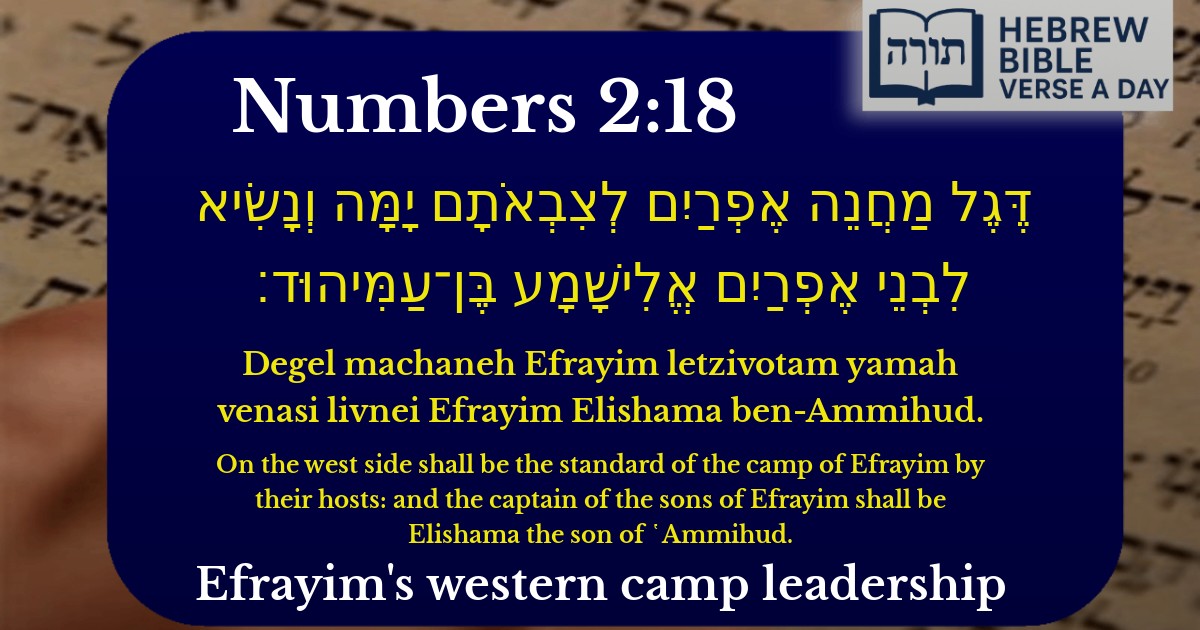Frequently Asked Questions
Q: What does the verse about the camp of Efrayim mean?
A: This verse describes the arrangement of the Israelite camp in the wilderness. The tribe of Efrayim was positioned on the west side under their banner (דֶּגֶל), led by their prince, Elishama. This was part of a divinely organized structure where each tribe had a specific place around the Mishkan (Tabernacle). Rashi explains that this orderly arrangement reflected the honor and unity of the Jewish people.
Q: Why is the tribe of Efrayim mentioned with a specific leader?
A: Each tribe had a designated leader (נָשִׂיא) to represent them, as the Torah emphasizes the importance of structured leadership. Elishama, the prince of Efrayim, was chosen for his merit. The Midrash (Bamidbar Rabbah) teaches that these leaders were righteous and played key roles in guiding their tribes spiritually and physically during the journey in the desert.
Q: What can we learn from the arrangement of the tribes around the Mishkan?
A: The organized encampment teaches the value of unity and respect for spiritual centrality. The Mishkan was at the heart of the camp, symbolizing that Torah and divine service should be the focus of Jewish life. Rambam (Hilchot Kli HaMikdash) derives from this that communal structure must always revolve around holiness, ensuring that every individual has a meaningful connection to Torah values.
Q: How does the concept of tribal banners (דֶּגֶל) apply today?
A: While we no longer have tribal banners, the idea of distinct identities within Jewish unity remains relevant. Each tribe had unique strengths, just as today, different Jewish communities have varied customs and roles—all united in serving Hashem. The Talmud (Shabbat 99a) notes that the banners inspired awe and reflected the beauty of Klal Yisrael’s diversity within shared purpose.
Q: Who was Elishama ben Ammihud, and why was he important?
A: Elishama was the prince of Efrayim, a descendant of Yosef, chosen for his leadership qualities. The Torah lists him to highlight that leadership is earned through righteousness, not just lineage. Sforno explains that his role included ensuring his tribe upheld Torah values, showing that true Jewish leaders must guide others in mitzvot and ethical conduct.


Position of the Camp of Efrayim
The verse describes the placement of the tribe of Efrayim in the encampment of the Israelites during their travels in the wilderness. According to Rashi (Bamidbar 2:18), the camp of Efrayim was positioned to the west of the Mishkan (Tabernacle), alongside the tribes of Menashe and Binyamin, forming the "Degel Machaneh Efrayim" (the banner of the camp of Efrayim). This arrangement was divinely ordained, as the tribes were organized in four groups surrounding the Mishkan, each with its own banner.
The Leadership of Elishama ben Ammihud
The verse identifies Elishama ben Ammihud as the prince (nasi) of the tribe of Efrayim. Ramban (Bamidbar 2:18) explains that the selection of leaders for each tribe was not arbitrary but reflected their noble lineage and spiritual stature. Elishama's leadership was significant, as Efrayim was a prominent tribe descended from Yosef, who had received Yaakov's blessing of preeminence (Bereishit 48:19-20). The Midrash (Bamidbar Rabbah 2:7) further elaborates that each tribal prince was chosen based on merit and divine wisdom.
Symbolism of the West
The placement of Efrayim to the west carries symbolic meaning. The Sforno (Bamidbar 2:18) notes that the west was associated with the setting sun, representing humility and submission to Hashem's will. Efrayim, despite its prominence, was positioned in a direction that signified deference to the Divine Presence in the Mishkan. Additionally, the Talmud (Yoma 37b) teaches that the western side of the Mishkan was particularly sacred, as it housed the Ark of the Covenant, further emphasizing the spiritual significance of Efrayim's placement.
The Role of Tribal Banners
The banners (degalim) of each camp were not merely for identification but carried deep spiritual symbolism. The Midrash (Bamidbar Rabbah 2:7) describes that each banner had unique colors and emblems corresponding to the tribe's ancestral roots. Efrayim's banner, according to some opinions, featured the image of a bull, symbolizing the strength of Yosef (Devarim 33:17). The banners also served as a unifying force, as the Talmud (Shabbat 99a) teaches that the Israelites were likened to a "bannered camp," reflecting their unity and divine order.